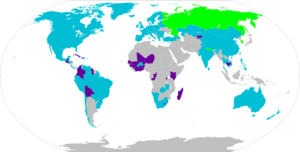Hague Adoption Convention facts for kids
The Hague Adoption Convention is an important international agreement. Its full name is the Hague Convention on Protection of Children and Co-operation in Respect of Intercountry Adoption. This agreement helps protect children when they are adopted from one country into a family in another. It makes sure adoptions are safe and happen smoothly.
How the Hague Adoption Convention Started
The idea for this convention was first suggested in May 1993. It was discussed at a big meeting in The Hague, a city in the Netherlands. The agreement officially started working in 1995.
Many countries have joined this agreement. For example, the United States officially agreed to follow it in December 2007. By May 2002, 46 countries had already joined. Some countries that have not joined do not allow adoptions from or to other countries.
Why the Convention is Important for Children
Adopting children from one country into a family in another is a fairly new idea. It became more common after World War II. By the 1970s, it was happening quite often.
However, people soon realized there were problems. There were not enough laws to protect children's rights during these adoptions. The Hague Adoption Convention was created in 1993 to fix these problems.
The Convention made countries and adoption agencies responsible. They must protect children from being trafficked. They also need to make sure adoptions are safe and happen quickly.
The convention also brought up some important questions. When a child is adopted, they might lose touch with their birth family. In an international adoption, a child might also lose their connection to their home country and culture.
Because of this, adoptions across countries should be a last choice. They should only happen after all efforts to find a family for the child in their own country have failed. Organizations like UNICEF also encourage countries to find families for children within their own borders first.
The Future of International Adoptions
In recent years, the number of international adoptions has gone down a lot. Some countries, like Romania, have stopped all adoptions to foreign families. Belarus and Ukraine also paused foreign adoptions for a time.
For example, China had 5,000 adoptions to other countries in 2005. This number dropped to 4,000 in 2006. In the past, wars or natural disasters often led to many adoptions from affected countries. But now, the world community prefers other solutions.
However, adoptions from some parts of Africa are increasing. The number of orphans from Liberia and Ethiopia grew between 2006 and 2008. The cost to adopt a child from another country has also gone up. This is partly because of the steps taken by the Convention. These steps help prevent any misuse of the adoption system.


